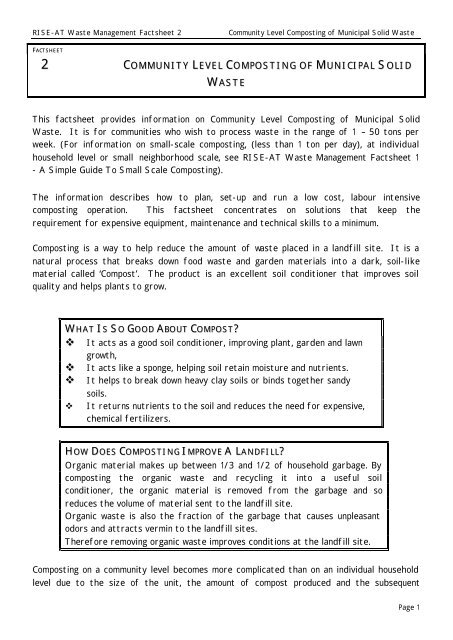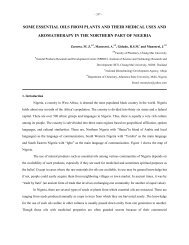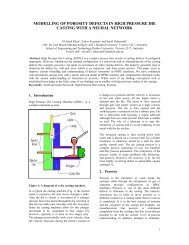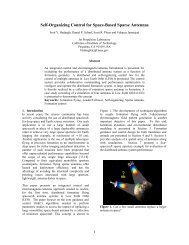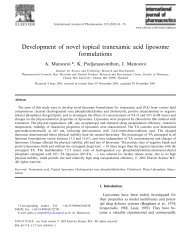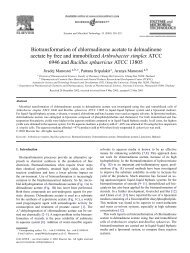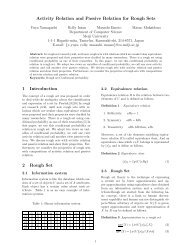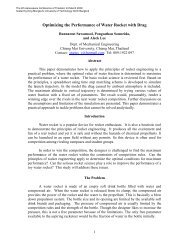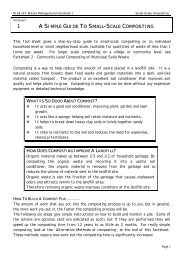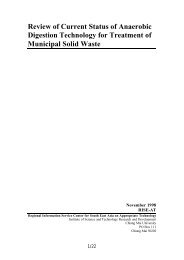COMMUNITY LEVEL COMPOSTING OF MUNICIPAL SOLID WASTE
COMMUNITY LEVEL COMPOSTING OF MUNICIPAL SOLID WASTE
COMMUNITY LEVEL COMPOSTING OF MUNICIPAL SOLID WASTE
Create successful ePaper yourself
Turn your PDF publications into a flip-book with our unique Google optimized e-Paper software.
RISE-AT Waste Management Factsheet 2<br />
Community Level Composting of Municipal Solid Waste<br />
FACTSHEET<br />
2 <strong>COMMUNITY</strong> <strong>LEVEL</strong> <strong>COMPOSTING</strong> <strong>OF</strong> <strong>MUNICIPAL</strong> <strong>SOLID</strong><br />
<strong>WASTE</strong><br />
This factsheet provides information on Community Level Composting of Municipal Solid<br />
Waste. It is for communities who wish to process waste in the range of 1 – 50 tons per<br />
week. (For information on small-scale composting, (less than 1 ton per day), at individual<br />
household level or small neighborhood scale, see RISE-AT Waste Management Factsheet 1<br />
- A Simple Guide To Small Scale Composting).<br />
The information describes how to plan, set-up and run a low cost, labour intensive<br />
composting operation. This factsheet concentrates on solutions that keep the<br />
requirement for expensive equipment, maintenance and technical skills to a minimum.<br />
Composting is a way to help reduce the amount of waste placed in a landfill site. It is a<br />
natural process that breaks down food waste and garden materials into a dark, soil-like<br />
material called ‘Compost’. The product is an excellent soil conditioner that improves soil<br />
quality and helps plants to grow.<br />
WHAT IS SO GOOD ABOUT COMPOST<br />
v<br />
v<br />
v<br />
v<br />
It acts as a good soil conditioner, improving plant, garden and lawn<br />
growth,<br />
It acts like a sponge, helping soil retain moisture and nutrients.<br />
It helps to break down heavy clay soils or binds together sandy<br />
soils.<br />
It returns nutrients to the soil and reduces the need for expensive,<br />
chemical fertilizers.<br />
HOW DOES <strong>COMPOSTING</strong> IMPROVE A LANDFILL<br />
Organic material makes up between 1/3 and 1/2 of household garbage. By<br />
composting the organic waste and recycling it into a useful soil<br />
conditioner, the organic material is removed from the garbage and so<br />
reduces the volume of material sent to the landfill site.<br />
Organic waste is also the fraction of the garbage that causes unpleasant<br />
odors and attracts vermin to the landfill sites.<br />
Therefore removing organic waste improves conditions at the landfill site.<br />
Composting on a community level becomes more complicated than on an individual household<br />
level due to the size of the unit, the amount of compost produced and the subsequent<br />
Page 1
RISE-AT Waste Management Factsheet 2<br />
Community Level Composting of Municipal Solid Waste<br />
costs involved. The aim of this factsheet is to provide sufficient information to guide you<br />
through the decisions that must be made when considering building a community<br />
composting site. Every community is different and will have its own requirements for the<br />
composting plant. With this information you should be able to design a facility that is<br />
right for the situation in your area.<br />
A composting facility can be developed without the purchase of specialised equipment and<br />
this factsheet explains how it can be done.<br />
1 - INVESTIGATE THE MARKET FOR COMPOST<br />
Before starting any work on building a community composting facility, it is essential that<br />
some time is spent investigating the economics of composting and the potential market for<br />
the compost in the local area.<br />
The compost is not precisely a fertilizer and the market for it in agriculture can be more<br />
potential than real.<br />
Therefore you must first find answers to the following questions:-<br />
What is the existing market for compost -<br />
Who buys it<br />
What do they use it for<br />
How much do they buy<br />
How much do they pay<br />
What is the potential for the msw compost product<br />
Who would be interested in the product<br />
How much would they be prepared to pay<br />
How much of the compost product would they buy<br />
At what time of year would they use the compost<br />
How could the market be increased<br />
What is the current situation with use of chemical fertilizers<br />
Who uses it<br />
How much do they pay<br />
What subsidies do they receive<br />
Would they be interested in changing to compost<br />
If the results of this study show that there is a market for the compost, the next step is<br />
to assess the waste situation in the area to decide on the size of the plant and the quality<br />
of product that can be produced.<br />
If the results show that there no real market for the product, there are steps that can<br />
be taken by local authorities to create a market.<br />
Page 2
RISE-AT Waste Management Factsheet 2<br />
Community Level Composting of Municipal Solid Waste<br />
MARKET DEVELOPMENT<br />
It has been found in many areas where composting has become part of the msw system,<br />
that active development of the compost market is essential. Government/Local Authority<br />
action to stimualte the market can include:<br />
♦ Use of the compost in all public works projects, including some high profile projects in<br />
parks and gardens.<br />
♦ Giving compost away free to garden centres and businesses.<br />
♦ Require that nurseries that supply plants to government funded projects use the<br />
compost.<br />
♦ Removing or modifying subsidies on chemical fertilizers that compete with the compost.<br />
Once you know how much you can sell the compost for and how much you are likely to be<br />
able to sell, you can use this information to estimate the income from the composting<br />
facility. This needs to be considered and compared to the expenditure and operating costs<br />
when designing the plant. Experience has shown that many plants using high cost<br />
machinery fail, as construction and operating costs exceed the revenue received from the<br />
sale of the compost. If the primary purpose of the composting facility is to reduce the<br />
amount of waste sent to a landfill, it may be possible to justify the composting facility<br />
that does not make a profit but covers the costs of producing the compost and breaks<br />
even.<br />
It is also important to note that during the composting process the organic waste will<br />
reduce in weight by up to 50%, so 2 tons of organic waste will produce 1 ton of compost.<br />
2 – CALCULATE THE REQUIRED SIZE FOR THE PLANT<br />
The next thing to consider is how much waste the community produces and how much of<br />
this will be composted. This can be used to calculate how many tons of waste per day the<br />
facility will receive.<br />
Consider the size of the community now and also the potential for growth over the next<br />
few years. A life-span of 8-10 years is a good basis for the calculation. Ideally the chosen<br />
site for the facility should have the area to expand as the amount of waste produced by<br />
the community increases.<br />
HOW MUCH <strong>OF</strong> THE <strong>WASTE</strong> IS ORGANIC <strong>WASTE</strong> THAT CAN BE COMPOSTED<br />
The following list gives an idea of the types of materials that can be used.<br />
• DRIED BROWN GRASS<br />
• STRAW<br />
• PRUNINGS AND CUTTINGS<br />
• DRY LEAVES<br />
• HAIR<br />
• CARDBOARD/PAPER<br />
• SAWDUST<br />
Page 3
RISE-AT Waste Management Factsheet 2<br />
Community Level Composting of Municipal Solid Waste<br />
• BARK CHIPS<br />
• GREEN GRASS/ GREEN LEAVES<br />
• FOOD SCRAPS (SEE NOTE BELOW)<br />
• VEGETABLE AND FRUIT PEEL<br />
• TEA BAGS/ C<strong>OF</strong>FEE GROUNDS<br />
• WEEDS (BEFORE THEY GO TO SEED)<br />
• CRUSHED EGG SHELLS<br />
• BREADS/COOKED RICE AND PASTAS<br />
• FLOWERS<br />
FOOD SCRAPS - In a small scale composting unit it is not advisable to add fish/meat/bone<br />
food scraps or oil/dairy products to the pile, to avoid attracting pests and to reduce odor<br />
problems. However for large scale composting these problems can be avoided by mixing<br />
the waste with the large amount of other organic material available.<br />
MATERIALS TO AVOID -There are a few organic materials that should not be<br />
composted:-<br />
CAT OR DOG <strong>WASTE</strong><br />
PLANTS OR GRASS CLIPPINGS THAT HAVE BEEN TREATED WITH CHEMICALS<br />
DISEASED OR INSECT INFECTED PLANTS<br />
CHARCOAL OR COAL ASHES<br />
WEEDS WITH MATURE SEEDS<br />
NAPPIES<br />
Obviously inorganic materials should not be included in the compost materials. These items<br />
include all Plastics/ Glass/Metals/Batteries/Electronic equipment etc.<br />
It may be necessary to take some samples of garbage to get an idea of the percentage of<br />
organic material in the waste. Usually between 30 – 50% of the waste is organic and can<br />
be composted.<br />
From this information you can calculate the amount of waste in tons/day, that you need to<br />
compost in the facility. Taking into account future potential growth in the community will<br />
allow you to design a plant that can grow to meet the increased waste requirements over<br />
the next few years.<br />
3 - QUALITY <strong>OF</strong> THE COMPOST<br />
The quality of the product will have a big influence on the success of the plant, but the<br />
process becomes more complicated and costly as the quality of the product increases. A<br />
balance must be reached between producing a good quality product that can be sold and<br />
the costs involved in the process.<br />
The quality of the compost is mainly dependent on the materials that are added to the<br />
composting mixture. If materials such as glass, metals, plastic, chemicals, etc are not<br />
removed from the waste they will remain in the finished compost product and contaminate<br />
it, reducing its potential for use as a soil conditioner for crops. These materials can be<br />
Page 4
RISE-AT Waste Management Factsheet 2<br />
Community Level Composting of Municipal Solid Waste<br />
dangerous and contaminate the soil that they are added to, rather than acting to improve<br />
it.<br />
The quality of the compost is therefore dependent on the system of separation that is<br />
used. There are a variety of separation methods and these are explained in the table<br />
below, with their advantages and their disadvantages.<br />
Method How This Is Achieved Advantages Disadvantages<br />
Source<br />
Separation<br />
Householders within the<br />
community separate the<br />
organic waste that can be<br />
composted into a special<br />
bin. This bin is collected<br />
separately from the other<br />
garbage and taken<br />
directly to the composting<br />
site. The waste is sorted<br />
by hand to remove any<br />
problem items before<br />
being composted.<br />
A clean, uncontaminated<br />
waste stream is produced<br />
for composting – which<br />
will produce a good quality<br />
compost.<br />
The amount of sorting<br />
that needs to take place<br />
at the composting site is<br />
small, and is therefore low<br />
cost and takes little time.<br />
Householders need to be<br />
educated and motivated to<br />
source separate the waste.<br />
An additional waste collection<br />
is required.<br />
An alternative to collection<br />
from individual houses can be<br />
to have community collection<br />
bins for organic waste.<br />
Mechanical<br />
Separation at<br />
The un-separated waste<br />
stream is delivered to the<br />
Health hazards from<br />
human exposure to<br />
High cost solution.<br />
the Composting<br />
composting site where it<br />
dangerous wastes is<br />
Generally found to suffer<br />
Site<br />
is passed through various<br />
mechanical separation<br />
reduced.<br />
from mechanical problems.<br />
machines (such as<br />
rotating drum screens,<br />
Small workforce required<br />
to operate separation<br />
Fails to produce a clean<br />
stream of compostable<br />
magnetic separators, etc),<br />
process.<br />
materials, so compost<br />
to separate the inorganic<br />
materials from the waste<br />
produced is contaminated and<br />
low quality.<br />
stream.<br />
Recyclable materials<br />
recovered are contaminated<br />
and difficult to sell.<br />
Hand Separation<br />
at the<br />
The un-separated waste<br />
stream is delivered to the<br />
Low cost solution<br />
compared to mechanical<br />
Health hazards from human<br />
exposure to dangerous wastes<br />
Composting Site<br />
composting site where it<br />
is sorted by hand to<br />
separation.<br />
is high.<br />
separate the inorganic<br />
Provides work for waste<br />
Large workforce required to<br />
materials and recyclables<br />
from the waste stream.<br />
pickers and other<br />
scavengers who may have<br />
operate separation process.<br />
previously sorted waste at<br />
the dump site.<br />
Difficult to produce a clean<br />
stream of compostable<br />
materials, so compost<br />
produced may be<br />
contaminated and lower<br />
quality.<br />
Recyclable materials<br />
recovered are contaminated<br />
and difficult to sell.<br />
Page 5
RISE-AT Waste Management Factsheet 2<br />
Community Level Composting of Municipal Solid Waste<br />
Method How This Is Achieved Advantages Disadvantages<br />
No Separation No separation occurs. The Low cost<br />
Produces a very contaminated<br />
contaminated waste<br />
compost product, which will be<br />
stream is composted as it<br />
is delivered to the site.<br />
The final compost product<br />
can be sieved to remove<br />
large contaminating items<br />
at the end of the<br />
composting process.<br />
Can be used as a method<br />
to stabilise the waste<br />
before it is added to the<br />
landfill site. Could be<br />
used as a daily or final<br />
cover for the landfill site.<br />
(Particularly useful where<br />
soil cover for landfill is in<br />
short supply and needs to<br />
be excavated and<br />
transported to the site).<br />
difficult to sell and may cause<br />
health hazards if used on<br />
crops.<br />
May operate successfully<br />
if only waste collected<br />
from markets is used, as<br />
this should have a high<br />
organic content.<br />
The two recommended methods of separation are:-<br />
1) Source Separation by Householders – This is the ideal option and is operated<br />
successfully in many countries. It will produce the best quality compost and simplify<br />
the preprocessing operations that are performed at the composting site. The key to<br />
successful implementation is educating the community on what to separate and<br />
motivating them so that they will bother to do it. This can be encouraged with financial<br />
incentives, such as increasing the collection fees for those who do not separate the<br />
waste.<br />
2) Hand Separation at the Composting Site - This is the best option if source separation<br />
cannot be achieved in the community, It requires several people to sort the waste by<br />
hand and can produce a reasonably clean stream of organic materials, the quality of the<br />
sorting depending on the number of people sorting the waste and the time taken. It is<br />
however impossible to completely remove all contaminants by hand separation and the<br />
compost will have more contamination than that produced from source separated waste.<br />
4 - SITING <strong>OF</strong> THE <strong>COMPOSTING</strong> FACILITY<br />
The compost system needs to be positioned on open land to allow sufficient room to<br />
establish and manipulate the compost piles. It should be a site that has:-<br />
i) Suitable access for transportation of the waste to the site.<br />
ii) A ‘buffer area’ between the site and nearby land-users, this is to minimize the<br />
nuisance of waste and compost odors.<br />
iii) Appropriate soil for absorption or collection of leachate.<br />
iv) Room to accommodate the amount of material that requires composting plus room to<br />
store finished compost material.<br />
v) A level, well drained surface.<br />
Page 6
RISE-AT Waste Management Factsheet 2<br />
Community Level Composting of Municipal Solid Waste<br />
vi)<br />
vii)<br />
Easy access to a source of water for wetting the compost piles.<br />
Adequate fencing and control to prevent it from becoming an open dump site and to<br />
keep unauthorized waste pickers out of the site.<br />
It may be appropriate to have the compost facility close to the landfill site. This will allow<br />
ease of transportation of rejected inorganic waste to the landfill and lower quality<br />
compost can be used as cover material at the landfill site.<br />
5 – DEFINE PRE-PROCESSING OPERATIONS<br />
Mechanical pre-processing is often the most costly part of a composting system, as well as<br />
the most vulnerable to breakdown. Therefore, if you are looking for a low cost, simple<br />
system it is recommended that pre-processing is minimized and manual labor is used<br />
wherever possible.<br />
Preprocessing can be split into two parts, separation of the compostable parts of the<br />
waste and chopping of the waste to ensure it is a suitable size for composting.<br />
SEPARATION – As discussed previously, the better the separation the better the quality<br />
of compost produced. Even if source separation can be organized, there is still a<br />
requirement for some level of sorting at the composting site, (although this will be a much<br />
smaller operation than if unsorted waste is delivered).<br />
Methods for sorting the waste by hand are:-<br />
1) For a low cost operation, the waste can be delivered to a sorting area, which consists of<br />
a concrete floor or paved area. Here the waste can be sorted by operators who pick<br />
out any recyclable goods or residues that cannot be composted. The sorting can be<br />
organised so that one person delivers the waste to the sorting area, a number of people<br />
sort the waste and one person takes the sorted organic waste to the next preprocessing<br />
stage.<br />
2) The waste can be placed on a moving belt and transported past stationary workers who<br />
hand pick the inorganic and uncompostable materials from the waste stream.<br />
The speed of the belt should not exceed 15m/min and its width should not be more<br />
than 1m, unless it is being worked from both sides. The belt should be flat and spillage<br />
prevented by retaining boards of wood or metal along both sides. The belt should be<br />
the height above the floor equal to the average elbow height of the workers. Boxes or<br />
baskets should be provided for workers to deposit the different waste fractions<br />
picked from the belt. The length of the belt and number of workers depends on the<br />
amount of waste being sorted and the amount of contamination in the waste stream.<br />
• It is recommended that workers wear gloves, adequate clothing and safety glasses<br />
to protect against injury from sharp objects. These should be supplied by the site<br />
management and rules that require the wearing of the safety items during all<br />
sorting activities should be strictly enforced.<br />
Page 7
RISE-AT Waste Management Factsheet 2<br />
Community Level Composting of Municipal Solid Waste<br />
CHOPPING - Materials should be chopped before they are added to the piles, the smaller<br />
the material the faster it will decompose. Carbons, in particular should be chopped into<br />
pieces 3-5 cm in size. Dried leaves can be shredded to reduce the volume before being<br />
added. It is not so important to shred Green materials as they will compost quickly<br />
anyway. However, it is IMPORTANT to remember that the pile needs to consist of particles<br />
of different sizes for the composting to work effectively. If all the particles are one size<br />
they will tend to clump together and decrease the flow of oxygen and moisture through<br />
the pile.<br />
Chopping can be done by hand using shears/axes etc or a small shredding machine can be<br />
used, operated by a small motor.<br />
6 – HOW TO COMPOST<br />
For waste to compost it needs the following:-<br />
- to be mixed with sufficient air, (if not it will decompose anaerobically, start to smell of<br />
bad eggs and produce methane, a flammable gas).<br />
- to have sufficient water<br />
- to have the right mixture of brown (carbon) and green (nitrogen) materials within the<br />
waste.<br />
If these things are controlled the decomposition of the waste into matured compost can<br />
be accelerated so that the compost is ready in about 8 weeks. As waste composts it<br />
heats up and this temperature rise is used to monitor the composting process and to kill<br />
any disease causing organisms that may be in the waste.<br />
There are many different methods that can be used to compost organic waste. For a low<br />
cost, community level composting facility treating up to 50 tons per week, it is<br />
recommended that a windrow system is operated with manual turning of the piles. A<br />
’windrow’ is simply an elongated pile of waste, as shown in figure 1.<br />
The composting methods proposed basically consist of building piles of waste, adding<br />
sufficient water and turning the piles at intervals to mix air into waste mixture. The<br />
following steps explain :-<br />
- How to build the pile to be the optimum size and design to increase the rate of<br />
decompositon.<br />
- How to monitor the pile to ensure that sufficient water is present.<br />
- How to monitor the temperature of the pile to see when the pile needs to be turned, so<br />
that more air is mixed with the waste.<br />
- How to turn the pile to ensure that the waste is well mixed with air and that all of the<br />
waste will at some time be in the centre of the pile and heated up to kill any disease<br />
causing organisms.<br />
Page 8
RISE-AT Waste Management Factsheet 2<br />
Community Level Composting of Municipal Solid Waste<br />
STEP 1 – HOW TO BUILD THE PILE<br />
Pile Design:- Two methods are described below, you can select either based on your<br />
requirements and the size of the composting facility.<br />
1) Standard Windrow Design<br />
Build elongated piles of waste, as shown in figure 1. Ideally they should be built on a well<br />
drained, impermeable surface, such as a paved or concrete surface. The ideal shape is a<br />
semicircular profile. The pile size should follow these guidelines:-<br />
Height – 1.5 to 2 m high. Any lower and the temperatures inside the pile will reduce, Any<br />
higher than 2m and the chances of anaerobic pockets developing in the pile are likely.<br />
Note the size of the pile is also important when turning. The higher the pile, the more<br />
difficult the manual turning process will be.<br />
Width – 1.5 to 2.0 m wide.<br />
Length – The length of the pile will have no effect on the biological composting process. It<br />
should be determined depending on the amount of waste being processed, the space<br />
available and the practicalities of the plant layout. It is sometimes convenient to have<br />
each windrow containing one days waste, this will simplify the turning rota.<br />
Figure 1 – Standard Windrow<br />
1.5 -<br />
2.0<br />
Length - not<br />
critical<br />
1.5 - 2.0<br />
m<br />
Page 9
RISE-AT Waste Management Factsheet 2<br />
Community Level Composting of Municipal Solid Waste<br />
2) Aeration Tunnel<br />
A small windrow is built on top of an aeration tunnel, as shown in figures 2 to 4. The<br />
aeration tunnel is made from bamboo and is used to assist with the aeration process by<br />
allowing air to circulate to the underside of the compost pile. Working to the dimensions<br />
shown below, each pile will contain 2-3 ton of waste. The pile still requires turning at<br />
regular intervals but the additional aeration can assist in speeding up the composting<br />
process. (This method has been operated successfully in Jakarta, Indonesia).<br />
0.5m<br />
2m<br />
3m<br />
Figure 2:<br />
Bamboo Aeration Tunnel<br />
Figure 3:<br />
Building the Pile<br />
Page 10
RISE-AT Waste Management Factsheet 2<br />
Community Level Composting of Municipal Solid Waste<br />
1.5<br />
1.7<br />
2.0<br />
Figure 4: The Finished Pile<br />
This system involves extra work in building the aeration tunnels but can benefit from a<br />
reduced composting time.<br />
Building The Pile:- The sorted, chopped waste should be piled up but should not be<br />
compacted as this will remove oxygen from the mixture. Water needs to be added to<br />
ensure that the waste is sufficiently wet and that the moisture is evenly distributed. One<br />
method of ensuring this is to add water after each layer of waste, about 30cm thick, has<br />
been added to the pile. The water content should be 45-50% by weight of the pile.<br />
To check the water content of the waste, pick up a handful of the material and squeeze.<br />
It should feel damp and be sufficiently wet that one or two drops of water are produced.<br />
STEP 2 - HOW TO MONITOR THE PILE<br />
The waste in the windrows needs to be turned regularly to ensure sufficient air is mixed<br />
with the material. This will keep any odors produced to a minimum. If there is a lack of<br />
oxygen in the pile it will begin to smell of bad eggs. Regular turning will also increase the<br />
decomposition rate of the waste.<br />
The temperature of the pile can be monitored and this will determine when it should be<br />
turned. The method for doing this is described below<br />
Page 11
RISE-AT Waste Management Factsheet 2<br />
Community Level Composting of Municipal Solid Waste<br />
Temperature and Composting:-<br />
If a compost pile has enough water and oxygen and a good balance of organic material,<br />
temperatures in the pile will rise and can reach 65°C. Heat is the result of the microorganisms<br />
that are decomposing the organic material.<br />
After building the pile it should heat up within a few days – this shows that it is working.<br />
If it does not it may not contain enough green materials or may be too dry. As the oxygen<br />
in the pile is used up the decomposition will slow down and so the temperature in the pile<br />
will drop. This drop in temperature is a good indication that it is time to turn the pile and<br />
add more oxygen.<br />
It is important to note that a temperature of 55°C or above is required for about 3 days<br />
to kill any pathogens, (disease causing organisms), that may be present in the waste.<br />
When starting a composting facility it is recommended that pilot tests are performed at<br />
first to determine the how often the piles should be turned and the time it will take<br />
before composting is complete. No definite figures can be provided here as these<br />
parameters will vary from place to place depending on the pile design, climate, waste<br />
contents, etc. These times can be determined by monitoring the temperature of the first<br />
few piles built and using the drop in temperature to determine when the piles should be<br />
turned. . Once the system has been running for a while, the regularity of turning the piles<br />
will become apparent and constant monitoring of every pile should not be necessary.<br />
Temperature Monitoring:-<br />
If you want to monitor the temperature of the pile accurately a thermometer can be used<br />
to take the temperature in the middle of the pile. It is often more accurate to take<br />
several readings at different points around the pile and to use the average of these<br />
values. In general the temperature should be between 45 – 65°C and if the temperature<br />
drops below 45°C the pile should be turned.<br />
An example of temperature monitoring is shown in Figure 5. Poles are used to make holes<br />
in three points around the pile, the thermometer should be placed in the hole and left for<br />
a few minutes, if the thermometer is small, it should be connected to a piece of string so<br />
that it can be pushed into the centre of the heap. The hole can then be covered to stop<br />
heat loss, and the string can be used to pull the thermometer out when ready. The reading<br />
must be taken as soon as the thermometer has been removed. If there is any delay the<br />
temperature reading will drop rapidly as it is affected by the ambient temperature.<br />
Page 12
RISE-AT Waste Management Factsheet 2<br />
Community Level Composting of Municipal Solid Waste<br />
Figure 5: Temperature Monitoring<br />
A more simple, non-technical method is to allow a metal rod to heat up in the middle of the<br />
pile. Take it out and hold the hot end. If it can be held comfortably in the hand for only 3<br />
seconds, the heap is hot enough and should be left. If it can be held comfortably for<br />
longer than 3 seconds the pile should be turned.<br />
You should find that the turning is required once every 5 to 7 days for piles of the size<br />
described in this factsheet.<br />
STEP 3 – HOW TO TURN THE PILE<br />
As the pile is turned:<br />
- Fresh air is mixed with the waste material<br />
- Excess heat is released<br />
- The material is broken up into smaller particles<br />
- The moisture content can be monitored and excess water added if necessary<br />
- Material from the outside of the pile is turned to the middle, where it will heat up.<br />
This will ensure that all of the material sees the higher temperatures at the middle of<br />
the pile. This will kill disease causing organisms in the waste and will also help to kill<br />
the fly larvae which often accumulate under the surface of a compost pile, see figure 6.<br />
Page 13
RISE-AT Waste Management Factsheet 2<br />
Community Level Composting of Municipal Solid Waste<br />
Cross-Section Through Windrow<br />
Area of Windrow that<br />
may be inhabited by fly<br />
larvae after about 5 days<br />
Figure 6 – Fly Larvae accumulate under the surface of a compost pile<br />
In order to ensure that the material from the outside is placed to the middle of the pile, a<br />
standard turning procedure should be used. Examples for both the standard windrow and<br />
the aeration tunnel piles are shown in Figures 7 –9. Note that available space around the<br />
pile is necessary when turning. Turning a windrow means that the pile is rebuilt in an<br />
adjacent windrow location, in a particular way, as shown in Figure 7. The pile can be<br />
turned by hand by a crew using spades and forks. To make the turning as easy as possible<br />
the old and new windrow positions should be close together. A gap of approximately 1m is<br />
suggested as a suitable distance.<br />
As the pile is being turned, if the compost is too dry, water should be added. The<br />
moisture content should continue to be 45-50% of the pile, and the moisture level can be<br />
checked using the technique explained in step 1.<br />
Page 14
RISE-AT Waste Management Factsheet 2<br />
Community Level Composting of Municipal Solid Waste<br />
Figure 7<br />
Turning Procedure for a Windrow<br />
Section Through Windrow Ready for Turning<br />
Section Through New<br />
For<br />
transverse<br />
turning<br />
Vacant Space at Side of<br />
Existing Windrow<br />
1<br />
1<br />
2<br />
2<br />
1<br />
3<br />
3<br />
2<br />
1<br />
4<br />
4<br />
3<br />
2<br />
1<br />
If mechanical turning is preferred, it can be done using a bulldozer, tractor or specialized<br />
windrow turning machine. (However, costs of purchasing and maintaining these machines<br />
are high).<br />
Page 15
RISE-AT Waste Management Factsheet 2<br />
Community Level Composting of Municipal Solid Waste<br />
Figure 8 : Turning Procedure for Aeration Tunnel (method 1)<br />
Section Through Pile Ready for Turning<br />
1<br />
2<br />
Area required either<br />
side for turning<br />
2<br />
1<br />
1 2<br />
1<br />
2<br />
2<br />
1<br />
Page 16
RISE-AT Waste Management Factsheet 2<br />
Community Level Composting of Municipal Solid Waste<br />
Figure 9 : Turning Procedure for Aeration Tunnel (method 2)<br />
Section Through Pile Ready for Turning<br />
Section Through New<br />
Pile<br />
1<br />
2<br />
gap approx 1m<br />
Vacant Aeration Tunnel<br />
1<br />
2<br />
1<br />
2<br />
1<br />
STEP 4 – HOW TO SCREEN AND MATURE THE COMPOST<br />
The compost is ready when it has become a dark, crumbly texture and has a fresh, slightly<br />
sweet smell. Very little of the original organic material should be identifiable. A constant<br />
temperature, below 45°C, also indicates that the process is complete. Depending on<br />
conditions, (moisture level/ number of times the compost has been turned, etc), the<br />
compost should be ready after about 4 – 5 weeks. Again, pilot tests monitoring<br />
temperature should be used to determine the time accurately for a new composting<br />
facility.<br />
Following the completion of this composting stage the compost must enter a maturing<br />
stage, which should be at least 2 weeks. This ensures that the compost is completely<br />
matured and safe to use.<br />
For the maturing stage the compost can be left in the pile or removed from the<br />
pile/windrow and moved to another area. In this way the windrow area can be used for<br />
new incoming waste. The size of the maturing pile is not so critical and the compost can be<br />
left in the pile until it is required for use.<br />
After the maturing phase the compost will require screening before it is ready to be sold<br />
as a soil conditioning product. (Alternatively this screening can be done before the<br />
maturing process if preferred.) This screening phase will remove any large pieces of<br />
cloth/plastic/glass etc that may not have been removed in the initial sorting process. This<br />
Page 17
RISE-AT Waste Management Factsheet 2<br />
Community Level Composting of Municipal Solid Waste<br />
will make the compost more marketable and remove contamination. Screening can be done<br />
in several ways. The most simple is to pass the compost through a metal screen. The size<br />
of the holes being selected to provide the required compost particle size.<br />
For general agricultural compost the screening size should be in the range of 25 - 40mm.<br />
Fragments of inert material, such as stones, plastic etc that are below this size are<br />
unlikely to interfere with the cultivation process and can remain in the finished compost.<br />
The most simple screening process is a manual process where compost is sieved through a<br />
screen by hand. If the amount of compost is too great for this a Rotary Screen or<br />
Vibrating Screen can be used. A Rotary Screen can be a simple perforated drum, setup at<br />
an angle, which is rotated by hand operation through a geared drive. The compost is<br />
placed in the upper end of the drum and as it rotates the compost is sieved through the<br />
holes. It can be placed at a height so that it can easily be loaded from the ground. The<br />
screened material can be discharged into a hand cart.<br />
Figure 10:<br />
Rotary Drum/Screen<br />
Drum Rotates<br />
Unscreened<br />
Compost In<br />
Residue<br />
Out<br />
Compost collected<br />
in handcart<br />
7 - LAYOUT <strong>OF</strong> COMPOST FACILITY<br />
The compost facility should be contained within a fenced area with a controlled gate to<br />
restrict access to the site.<br />
A receiving area and sorting/chopping area needs to be positioned so that it can be<br />
accessed easily for waste deliveries to the site and from where the sorted waste can be<br />
easily moved to the windrow area. The windrows need to be positioned sufficiently far<br />
apart so that they are easy to access for building but close enough to vacant areas for<br />
turning purposes. There should ideally be some cover for the piles to shade them from the<br />
Page 18
RISE-AT Waste Management Factsheet 2<br />
Community Level Composting of Municipal Solid Waste<br />
hot sun, (to prevent them from drying out) and to protect them from getting too wet<br />
during the rainy season.<br />
The number of windrow spaces required depends on the amount of waste received each<br />
day and the retention period of the waste in the windrows. The site needs to be designed<br />
so that there is always space around the windrows that require turning.<br />
To help with the supply of water an underground water pipe can be laid under the site with<br />
hose connections at various intervals. These must be below ground level and covered with<br />
metal flaps to prevent damage by vehicles or equipment on the site.<br />
There should also be adequate area for storing and bagging the finished compost product.<br />
Demand for compost is likely to be seasonal, so a storage area for stock build-up will be<br />
useful.<br />
OTHER POINTS <strong>OF</strong> INTEREST<br />
• The site should be kept clean and tidy at all times. After windrow turning, building or<br />
dismantling operations the area should be swept to clear any debris. The will keep<br />
smells to a minimum and stop the site from looking like a dump site.<br />
• Inorganic residues sorted from the organic waste should be removed from the site<br />
regularly. They should not be allowed to build up in unsightly piles around the site.<br />
• Waste that is delivered to the site should be sorted, processed and built into a new<br />
pile on the same day, wherever possible. This prevents the waste from decomposing<br />
anaerobically and smelling before it gets to the compost piles.<br />
• Safety Regulations for all workers should be strictly enforced. This should include the<br />
wearing of appropriate safety clothing and the correct use of all equipment and<br />
machinery.<br />
Page 19
RISE-AT Waste Management Factsheet 2<br />
Community Level Composting of Municipal Solid Waste<br />
EXAMPLES <strong>OF</strong> <strong>COMPOSTING</strong> SYSTEMS IN OPERATION:-<br />
Example 1 – Manual Windrow composting<br />
The facility processes approximately 3 tonnes of organic waste per day. Therefore each<br />
day a windrow is built consisting of the days waste input. Each windrow is about 2m wide,<br />
1.5m high and 2-3m long, with a volume of approximately 9m 3 and is turned on the 6 th and<br />
11 th days. On the 16 th day the windrow is broken down and passed through a manually<br />
operated screen, before being taken to a maturing heap where it is left for 30 days to<br />
stabilize.<br />
A typical 16 day rota is shown below in Figure 11. Note that this is for a 16 day period<br />
after the facility is fully operating with 16 windrows. (At start-up the rota will build up<br />
slowly as each new windrow is made).<br />
Windrow No.<br />
1 2 3 4 5 6 7 8 9 10 11 12 13 14 15 16<br />
DAY 1 B F T2 T1<br />
DAY 2 B F T2 T1<br />
DAY 3 B F T2 T1<br />
DAY 4 B F T2 T1<br />
DAY 5 B F T2 T1<br />
DAY 6 T1 B F T2<br />
DAY 7 T1 B F T2<br />
DAY 8 T1 B F T2<br />
DAY 9 T1 B F T2<br />
DAY 10 T1 B F T2<br />
DAY 11 T2 T1 B F<br />
DAY 12 T2 T1 B F<br />
DAY 13 T2 T1 B F<br />
DAY 14 T2 T1 B F<br />
DAY 15 T2 T1 B F<br />
DAY 16 F T2 T1 B<br />
Figure 11: Typical Turning Rota (Example from ref 1)<br />
B = Build New Windrow<br />
T1 = First Turn of Windrow<br />
T2 = Second Turn of Windrow<br />
F = Finish Composting Stage – break down windrow and move to maturing stage<br />
Each day one windrow is built, two are turned and one is broken down and moved to the<br />
maturing stage. Note that this plant has a relatively short composting stage (16 days) and<br />
a longer maturing stage 30 days.<br />
The system requires 20 windrow spaces so that there is always sufficient space for<br />
turning. An example of a sequence of turning is shown in figure 12.<br />
Page 20
RISE-AT Waste Management Factsheet 2<br />
Community Level Composting of Municipal Solid Waste<br />
Figure 12:<br />
Example of turning sequence for windrows.<br />
Day 1<br />
Build 1<br />
Day 11<br />
Turn<br />
1 2 3 4 5<br />
Build<br />
11<br />
Turn<br />
6<br />
7 8<br />
9<br />
10<br />
Day 2<br />
1<br />
Build 2<br />
Day<br />
1<br />
11<br />
2<br />
Turn<br />
Build<br />
Turn<br />
3 4 5<br />
6<br />
7 8<br />
9<br />
10<br />
Day 3<br />
1<br />
2<br />
Build 3<br />
Day<br />
1<br />
11 2 1<br />
Tur<br />
3 4 5<br />
Tur<br />
Build<br />
13<br />
6<br />
7 8<br />
9<br />
10<br />
Day 4<br />
Day<br />
Turn<br />
1<br />
2 3<br />
Build<br />
1<br />
11 2 12 3 13 4 5<br />
Turn<br />
6 7 8<br />
9Build<br />
10<br />
Day 5<br />
1<br />
2 3 4<br />
Build 5<br />
Day<br />
1<br />
11 2 12 3 13 4 14 5<br />
6 7 8 9<br />
Turn<br />
Bld<br />
Turn<br />
1<br />
Day 6<br />
Turn<br />
Day 16<br />
Turn<br />
Build 6<br />
1<br />
2 3 4 5<br />
1 2 12 3 13 4 14 5<br />
Turn<br />
1<br />
6<br />
Build 16<br />
15<br />
7 8 9 10<br />
Day 7<br />
6<br />
1<br />
Build<br />
Turn<br />
2 3 4 5<br />
Day 17 Turn<br />
11 1 3 1 4 1 5<br />
2<br />
Turn<br />
Build 17<br />
6 1 7 8<br />
9<br />
1<br />
1<br />
Day 8<br />
6<br />
Turn<br />
1 2 3 4 5<br />
7<br />
Build 8<br />
Day<br />
1 1 13 4 14 5<br />
3<br />
Turn<br />
6 1 7 17 8<br />
Tur<br />
Build 18<br />
9<br />
15<br />
1<br />
Day 9<br />
Turn<br />
Day<br />
Turn<br />
6<br />
1 2 3 4 5<br />
7 8<br />
Build 9<br />
11 12 13 1 5<br />
6 16 7 17 8<br />
18<br />
4<br />
9<br />
Build 19<br />
Turn<br />
15<br />
10<br />
Day 10<br />
Turn<br />
Day 20<br />
Tur<br />
6<br />
1 2 3 4 5<br />
7 8 9<br />
Build 10<br />
1<br />
12 13 14 15<br />
6 16 7 1 8<br />
18 9 1<br />
5<br />
1<br />
0<br />
Build 20<br />
Tur<br />
Page 21
RISE-AT Waste Management Factsheet 2<br />
Community Level Composting of Municipal Solid Waste<br />
You can see that after day 16, when the facility is operating at full capacity, each day one<br />
windrow is removed, one is turned into the free space created, another is turned and the<br />
free space created is used to build that days new pile. This can be organised so that the<br />
sequence of activities is such that the first activity of the day is to turn the windrow that<br />
creates the free space for building the new pile. Then the new pile can be built while the<br />
other activities are going on. Also the pile to be removed and passed on to the maturing<br />
phase needs to be removed before the second pile can be turned into the free space.<br />
There are many other sequences and layouts that can be used, such as placing the<br />
windrows in a circle. Each will have its own requirements for organisation and turning and<br />
needs to be considered and planned at the beginning of the project. The plan may require<br />
changing/updating once the pilot tests have been carried out and more precise data is<br />
available on the composting times and turning periods that are to be used.<br />
Example 2 – Aeration Tunnel Method used in Jakarta, Indonesia (Ref 2)<br />
Several facilities in Jakarta use the Aeration Tunnel method to process piles of 2-3 ton of<br />
waste. The piles are left for 35 days to compost, turning each pile once every 7 days.<br />
Therefore each pile is turned 4 times before it is dismantled and taken to the maturing<br />
phase. Maturation takes 14 days, after which the compost is manually screened and<br />
packed, ready for sale. The compost is sold in bags from 1 to 10 Kg.<br />
Due to the longer composting time, if one pile is built per day there is a total of 35 piles<br />
once the system is fully operating.<br />
REFERENCES<br />
Information for this factsheet was compiled form a number of sources including:-<br />
Updated 22/12/98<br />
1. Management of Solid Wastes in Developing Countries, F.Flintoff, World Health<br />
Organisation, 1984. ISBN 9290221011 (Available from CMU Medical Faculty Library<br />
- WA 778 F623m).<br />
2. Practical Handbook on Composting, UDPK Composting Technique. (Available from<br />
RISE-AT Library).<br />
3. Organic Waste, I.Lardinois, A. van de Klundert, TOOL 1993. (Available from RISE-AT<br />
Library 369).<br />
4. Low Cost Composting, E.I Stentiford et al, University of Leeds, 1996. (Available from<br />
RISE-AT Library 363).<br />
5. Municipal Solid Waste Management Handbook, Sound Practices - Composting, UNEP<br />
International Environmental technology Centre. (Available from<br />
www.unep.or.jp/ietc/ESTdir/pub/MSW/index).<br />
Page 22


